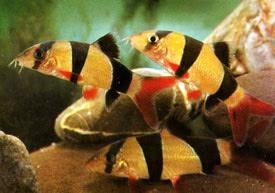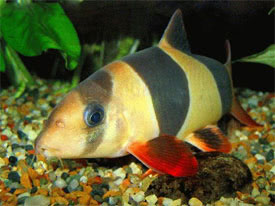
 Magyarul / Hungarian
Magyarul / Hungarian



- Scientific name: Chromobotia macracanthus
- Synonyms: Botia macracantha, Cobitis macracanthus, Chromobotia macracanthus
- Common name: Clown loach, Clown botia
- Group: Loaches
- Habitat: Asia; Sumatra, Borneo.
- Size: 30-35 cm
- Biotope: Inhabits both flowing and still parts of rivers and lakes in Southeast Asia.
- Social behavior: A good community fish to combine with medium to large sized species. The Clown Loach should be kept in schools of five or more fish as smaller groups do poorly. Clown Loaches are nocturnal and shy when first introduced, but soon become friendly towards their owner.
- Diet: Tablets, live, worms, snails, crustaceans, insect larvae; occasionally algae.
- Breeding: Not bred in captivity
- Tank: Minimum 300 litres
- Population: 5 fish for 400 litres
- Decoration: Provide numerous hiding places with caves, driftwood, and roots.
- Temperature: 26-27°C
- pH: 6-6,5.
- Hardness: 5-12 NK°
- Lifespan: 10 years
Description: Moderately elongated and laterally compressed, the Clown Loach has an arched back. It has a straight body profile, a large head, and a mouth that faces downward. Four pairs of barbels surround its mouth. The Clown Loach has a small spine by its eyes, that often gets entangled in net mesh. The body coloration is orange, but paler at times when weak or frightened. Three broad, transverse black bands. The first, runs through the eye; the second starts in front of the dorsal fin and runs down to the belly; the third begins on the dorsal fin and extends to the anal fin. The caudal, pectoral, and anal fins are all red in color.
Not bred in captivity; most likely because they have probably never reached sexual maturity in an aquarium. In nature, the Clown Loach spawns during the rainy season in foaming, fast-flowing streams, spring fed creeks, and rivers. The fry move down to slower moving and estuaries of the same rivers, to grow up. Rumors of spawnings in captivity have not been proven. In Southeast Asian fish farms, some have claimed success by using hormone injections.




